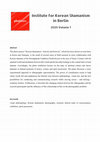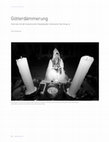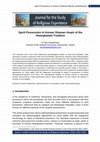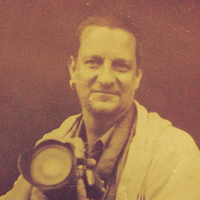Books by Dirk Schlottmann
Verlagshaus Monsenstein und Vannerdat OHG. Edition MV-Wissenschaft: Münster, 2016
Selbstverlag: Blurb Inc. San Francisco, 2011
Europäische Hochschulschriften. Volkskunde/Ethnologie. Peter Lang Verlag: Frankfurt, Bern, 2007
Papers by Dirk Schlottmann

Shaman – Journal of the International Society for Academic Research on Shamanism. Vol. 28. no 1 & 2, p. 63-95, 2020
This ethnographic study, based on extensive fieldwork conducted in Seoul
and its suburbs between ... more This ethnographic study, based on extensive fieldwork conducted in Seoul
and its suburbs between 2008 and 2017, examines the shamanic death ritual
jinjinogigut of the Hwanghaedo tradition imported from North Korea. The
jinjinogigut is a shaman ritual for recently deceased people. The exploration of
this ritual presents the researcher with various culture-specific challenges, issues
of spirituality and science, and seeming contradictions. This article categorizes
and explains terms, examines various spiritual aspects of the ritual and unravels
ambiguities. In most cases, previous studies have concentrated on the form of the
ritual, all but ignoring the nuanced role of the shaman who conducts the transcendent
ritual. This paper references the form while investigating the content of
the jinjinogigut, using the shaman’s point of view as a focal point for analysis of
the ceremony from both scientific and religious perspectives.

photum - photography and humanism, 2020
The photo project "Korean-shamanism-betwixt and between", which has been shown several times in K... more The photo project "Korean-shamanism-betwixt and between", which has been shown several times in Korea and Germany, is the result of several years of field research in close collaboration with Korean shamans of the Hwanghaedo-Tradition (North-Korea) in the area of Seoul. Contact with the spiritual world and mediation between this world and the hereafter belongs to the central tasks of each shaman. Accordingly, the photo exhibition focuses on the topic of spiritual contact and shows shamans in liminal moments of trance, ecstasy and spirit possession. The paper discusses a more experimental approach to ethnographic representation. The power of visualization seems to help where words fail and emphasizes the blurred zone between anthropology, visual arts, and the new possibilities for conducting and communicating research whilst moving across-and defying-academic borders. Furthermore, it describes the changing relation between the ethnographer and his research participants and the influence of this relationship in flux on the photographic portfolio. keywords visual anthropology, Korean shamanism, photography, research, altered states of consciousness, exhibition, spirit possession

Shaman – Journal of the International Society for Academic Research on Shamanism. Vol. 27. no 1 & 2, p. 65-95, 2019
Shamanism is still a popular form of spiritual-religious practice despite recent socioeconomic de... more Shamanism is still a popular form of spiritual-religious practice despite recent socioeconomic development in South Korea. The following essay examines the changes in jaesugut (ritual for happiness) and uhwangut (ritual against misfortune), both adapted to the demands of modern urban life. These adjustments are a response to social transformations and the resulting altered ideas of happiness and success. The emphasis on this worldly wish-fulfillment of Korean shamanism is a mirror of the zeitgeist and allows insights into people's wishes, needs and worries. In addition, this investigation examines how shamans, clients and spirits address and discuss the causes of good and bad fortune during the rituals. The ritual is an endeavor to make sense of the human experience and creates a spiritual reconstruction of reality that aims to transform the participant's negative emotions into meaningful experiences and to overcome crisis. Ritual efficacy is based on the competence of the shaman to act as a mediator between the human and supernatural worlds and to connect these spheres meaningfully and creatively with each other. The analysis of the rituals is the result of several years of field research in close collaboration with Korean shamans of the Hwanghaedotradition in the area of Seoul.
brennpunkt - Magazin für Fotografie, 2019

Korea Forum, Dec 8, 2018
Sie wurde 1955 in Ulleong-do geboren und erlebte sinbyeong, die koreanische Schamanenkrankheit, b... more Sie wurde 1955 in Ulleong-do geboren und erlebte sinbyeong, die koreanische Schamanenkrankheit, bereits in frühen Jugendjahren. 1981 wurde sie als Schamanin initiiert. Sie arbeitete mit verschiedenen Schamaninnen, bis sie schließlich ihre eigene Schamanengruppe zusammengestellt hatte. Han Gong-Ju pflegt eine große und treue Gemeinde (dangol), die sie mit Rat und Tat durchs Leben begleitet. Mittlerweile betreut sie bei einigen Familien bereits die dritte Generation. Seit 2009 leitet sie den sasin gutdang. Die Krise der koreanischen Regierung, die in der Abwahl der Präsidentin Park Geun-Hye gipfelte, basierte im Wesentlichen auf Korruptionsvorwürfen, die im Zusammenhang mit Geldwäsche, Erpressung und Amtsmissbrauch stehen. Eine zentrale Figur in der verfilzten und undurchsichtigen Geschichte ist Parks Jugendfreundin und Vertraute Choi Soon-Sil. In den Medien wurde Choi Soon-Sil als Schamanin beschrieben, die über Jahre ihren Einfluss auf die Präsidentin ausgebaut und intensiviert habe. Einige Journalisten haben die Präsidentin als ihre Marionette bezeichnet. Wieder einmal ist der koreanische Schamanismus als eine Art Teufelskult diffamiert worden. Hat diese negative Berichterstattung Einfluss auf ihren Alltag als Schamanin gehabt? Natürlich ist die Behauptung, dass die Krise der Regierung durch den Einfluss einer Schamanin entstanden sein soll, nicht spurlos an unserem Alltag vorbeigegangen. Über Wochen war das gutdang kaum gebucht. Viele Schamaninnen haben Rituale verschoben oder abgesagt. Kunden haben sich distanziert oder sind zu vereinbarten Terminen nicht erschienen. Insgesamt war es über Monate ruhiger in der Schamanenszene und viele Schamaninnen haben Verluste beklagt. Das ist aber, ehrlich gesagt, kein neues Phänomen. Solange ich denken kann, werden alle religiösen Irrungen und Wirrungen erst einmal in den Kontext Schamanismus gestellt. Ich erinnere

Issue 4 ©2018 Journal for the Study of Religious Experience, 2018
The Cartesian view of the world influenced anthropological studies of ritual and spirituality. Sp... more The Cartesian view of the world influenced anthropological studies of ritual and spirituality. Spirit possession studies in particular suffer from this Western idiosyncrasy, because many anthropologists who write about possession argue that possession cults and rituals are " just " traditional performances for treating psychosomatic illness brought about by disharmonies in the social order. A spiritual reality, as perceived by the participants of religious rituals and shamans is in principle excluded. This reduction of the psycho-social aspects of spirit possession ignores a "transcendent reality," where physical and spiritual experiences can be an expression of individual and culturally specific reality. In this article, I analyse the various anthropological perspectives on spirit possession and compare the epistemological approaches on " ritual reality " with the indigenous terminology for states of possession of Korean Hwanghaedo-shamans from Seoul. The Hwanghaedo tradition of Korean shaman is particularly ecstatic and moments of spirit possession exist in many variations. For this reason, the analysis is focused on this tradition.
Korea Photo Review, Vol 2, November 2017, S. 4-11
Inspired Eye 29 (Photography Magazin), Dec 2015
Journal of International Studies (국제학논총) / Keimyung University, Apr 2015
DAF-Szene Korea, Jun 2014
Hyundai Magazin - das Kundenmagazin von Hyundai Motor Deutschland. Ausgabe 1/14.
Kultur Korea – Ausgabe 2014/1, S. 13-16 Quartalsmagazin des Koreanischen Kulturzentrums (Kulturabteilung der Botschaft der Republik Korea), Mar 3, 2014
Institute of Global Cyber Society Kyung Hee Cyber University (경희사이버대학교), Jan 10, 2014
K-Colors of Korea Deutschsprachiges Onlinemagazin für koreanische Kultur und Popkultur, Oct 15, 2013











Uploads
Books by Dirk Schlottmann
Papers by Dirk Schlottmann
and its suburbs between 2008 and 2017, examines the shamanic death ritual
jinjinogigut of the Hwanghaedo tradition imported from North Korea. The
jinjinogigut is a shaman ritual for recently deceased people. The exploration of
this ritual presents the researcher with various culture-specific challenges, issues
of spirituality and science, and seeming contradictions. This article categorizes
and explains terms, examines various spiritual aspects of the ritual and unravels
ambiguities. In most cases, previous studies have concentrated on the form of the
ritual, all but ignoring the nuanced role of the shaman who conducts the transcendent
ritual. This paper references the form while investigating the content of
the jinjinogigut, using the shaman’s point of view as a focal point for analysis of
the ceremony from both scientific and religious perspectives.
and its suburbs between 2008 and 2017, examines the shamanic death ritual
jinjinogigut of the Hwanghaedo tradition imported from North Korea. The
jinjinogigut is a shaman ritual for recently deceased people. The exploration of
this ritual presents the researcher with various culture-specific challenges, issues
of spirituality and science, and seeming contradictions. This article categorizes
and explains terms, examines various spiritual aspects of the ritual and unravels
ambiguities. In most cases, previous studies have concentrated on the form of the
ritual, all but ignoring the nuanced role of the shaman who conducts the transcendent
ritual. This paper references the form while investigating the content of
the jinjinogigut, using the shaman’s point of view as a focal point for analysis of
the ceremony from both scientific and religious perspectives.